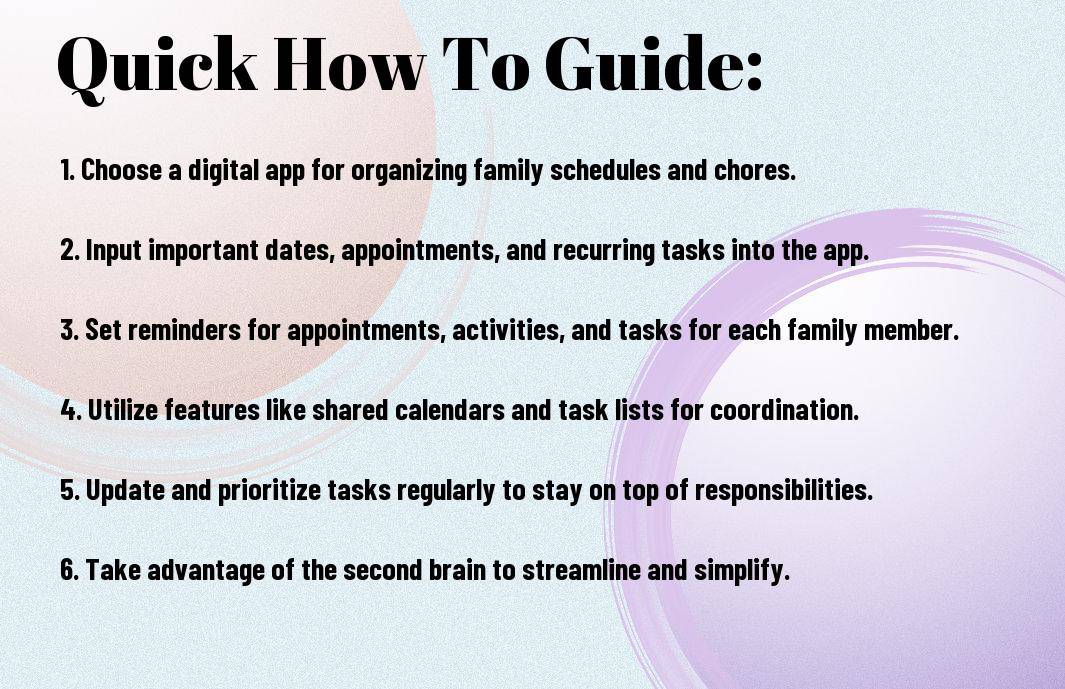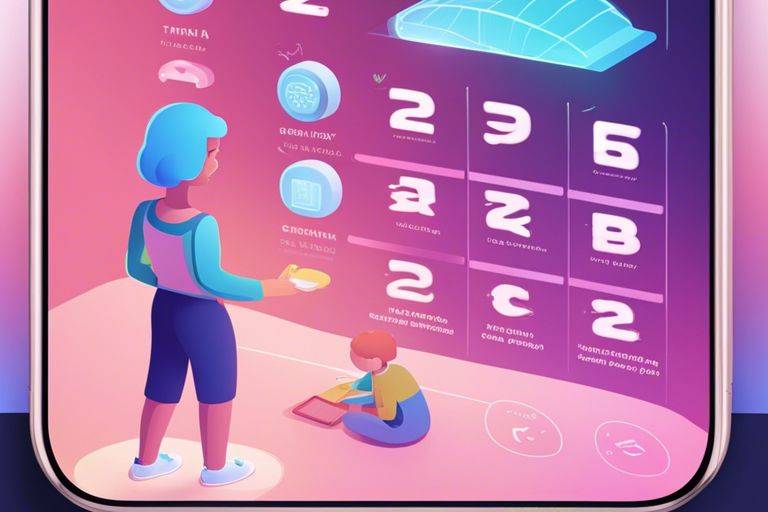Efficiency is key when it comes to juggling the demands of family life as a busy parent. Using the second brain technique can be a game-changer in helping you stay organized, on top of schedules, and reduce stress. Imagine having a digital extension of your memory to store all important details and tasks, making it easily accessible whenever you need it.
Key Takeaways:
- Utilize tools: Make use of digital tools like calendars, task managers, and family organizers to keep track of schedules and responsibilities.
- Sync with partner: Share your digital calendar with your partner to coordinate family events and stay organized together.
- Set priorities: Identify important tasks and prioritize them to make efficient use of your time and energy.
- Delegate tasks: Assign age-appropriate chores to your children to teach responsibility and lighten your load.
- Practice self-care: Take time for yourself to recharge and prevent burnout, whether it’s through exercise, reading, or hobbies.
- Meal planning: Plan meals ahead of time to reduce stress and ensure your family is eating healthy and balanced meals.
- Communicate openly: Keep open lines of communication with your family members to share responsibilities, solve problems, and support each other.

Understanding the Second Brain
What Is the Second Brain?
Assuming you’re a busy parent trying to juggle work, family, and personal life, you might feel overwhelmed by the amount of information you need to remember on a daily basis. This is where the concept of the second brain comes in to save the day. The second brain is a term used to describe the idea of leveraging external tools and systems to offload cognitive load from your primary brain.
Key Components of the Second Brain System
Clearly, the second brain system consists of various components that aid in organizing and managing the vast amount of information that you encounter every day. The main components include digital tools, such as note-taking apps, calendars, and task managers, that help you capture, store, and retrieve information efficiently.
Brain. It is vital to understand how each component of the second brain system works and how they can be integrated to create a seamless workflow. By utilizing these tools effectively, you can enhance your productivity and reduce the mental strain of trying to remember everything off the top of your head.
Another crucial aspect of the second brain system is establishing routines and habits that support the use of these tools. By developing a consistent practice of inputting information into your second brain and regularly reviewing and organizing it, you can significantly improve your ability to stay on top of your family’s busy schedule and commitments.

Getting Started with Your Second Brain
All parents can benefit from implementing a second brain system to effectively manage their family life. This tool can help you stay organized, remember important details, and streamline your daily tasks. By utilizing a second brain, you can free up mental space and reduce the stress that comes with juggling multiple responsibilities.
Tools and Apps to Build a Second Brain
On your journey to creating a second brain, it’s important to choose the right tools and apps that align with your preferences and lifestyle. Tools like Evernote, Notion, and Trello are popular options that offer features for note-taking, task management, and organization. These platforms allow you to store information, set reminders, and collaborate with family members, making it easier to keep track of schedules, to-do lists, and important documents.
Setting Up for Success: The Initial Framework
Even though the idea of setting up a second brain system may seem overwhelming at first, it’s crucial to start with a solid framework that will guide your organization process. Begin by defining your goals and priorities, as well as outlining the areas of your family life that require the most attention. Create a system of organization that works for you, whether it’s based on time-blocking, project lists, or categorized folders. Consistency and habit-building are key to establishing a successful second brain that will help you navigate the demands of parenthood with greater ease.
How to Integrate the Second Brain into Daily Family Life
Many parents today are juggling multiple responsibilities, trying to keep up with work, household chores, and taking care of their families. The concept of the “second brain” can be a game-changer in managing the chaos of daily life. By leveraging digital tools and technology, you can create a system that helps you stay organized, remember important details, and streamline communication within your family.
Creating Daily Routines with Your Second Brain
Even with the best intentions, it can be challenging to stick to a daily routine with so many distractions and unexpected events. However, with your second brain, you can set up reminders for tasks, appointments, and even quality time with your loved ones. By syncing your schedules and to-do lists, you can ensure that everyone in the family is on the same page and that nothing falls through the cracks.
Centralizing Family Information for Easy Access
While it’s common to have family information spread across different platforms like calendars, email threads, and sticky notes, this can lead to confusion and missed deadlines. By centralizing all your family’s information in your second brain, you can have a single source of truth that everyone can access. This can include important dates, meal plans, school schedules, and more. With everything in one place, you can save time searching for information and focus on what truly matters.
For instance, you can create a shared digital calendar where everyone can input their appointments and activities. You can also use a note-taking app to jot down ideas and action items that need to be addressed. By embracing the power of your second brain, you can transform chaos into order and spend more quality time with your family.

Time Management Tips for Busy Parents
To effectively manage their family life, busy parents can use their Second Brain to streamline tasks and schedules. By incorporating time management strategies and tools, parents can prioritize family commitments and ensure that their daily routines run smoothly.
Prioritizing Family Commitments with the Second Brain
Prioritizing family commitments is crucial for busy parents. By utilizing the Second Brain to organize tasks and deadlines, parents can ensure that they are dedicating enough time to each family member and important events. Setting reminders and creating to-do lists can help parents stay on top of their responsibilities and prevent any last-minute chaos.
This approach allows parents to focus on what truly matters, such as quality time with their children, while efficiently managing other aspects of their lives. By utilizing the Second Brain to prioritize family commitments, parents can create a balanced and fulfilling family life.
Streamlining Tasks and Schedules
One way to streamline tasks and schedules is to plan ahead. By utilizing the Second Brain to create a weekly or monthly schedule, parents can allocate specific times for tasks such as grocery shopping, meal prep, and house cleaning. This helps parents stay organized and ensures that no task is overlooked.
By using the Second Brain to streamline tasks and schedules, busy parents can maximize their efficiency and make the most of their limited time. This approach can help parents create a stress-free environment for their families, promoting a positive and harmonious home life.
Managing Family Finances Using the Second Brain
Despite the hectic schedule that comes with being a busy parent, it is necessary to stay on top of family finances to ensure a secure future. By leveraging tools like the Second Brain, you can streamline the process and make managing money easier. For tips on how to improve your time management skills as a parent, check out Mastering Time Management As A Busy Parent Of Two.
Tracking Expenses and Budgeting
On a practical level, the Second Brain can be incredibly helpful in tracking expenses and creating a budget for your family. By digitizing receipts, categorizing expenses, and setting budget limits, you can gain a clearer picture of where your money is going. This helps in identifying areas where you can cut back and save more effectively for your family’s future.
Planning for Future Family Goals
On a more strategic level, the Second Brain can assist you in planning for future family goals such as saving for education, buying a home, or setting up a retirement fund. By setting reminders, creating timelines, and breaking down goals into manageable steps, you can stay on track and achieve financial milestones. Understanding the power of visualization and organization in the Second Brain can help you prioritize your family’s long-term financial well-being. By having a clear roadmap and financial plan, you can ensure that you are working towards a secure and prosperous future for your loved ones.
Enhancing Communication and Reducing Conflicts
Unlike other productivity tools, the Second Brain method offers a holistic approach to managing family life. For a detailed guide on how to implement this method, check out Building My Second Brain [Episode 241]. One area where the Second Brain can be particularly beneficial is in enhancing communication and reducing conflicts within the family.
Coordinating Calendars and Appointments
Clearly, one of the biggest sources of confusion and conflict in busy family life is managing multiple schedules. Using your Second Brain to coordinate calendars and appointments can help streamline this process. By centralizing all important dates and commitments in one place, you can ensure that everyone is on the same page and avoid double bookings or missed events. Encourage all family members to input their schedules regularly to keep things organized and running smoothly.
Effective Decision-Making with Family Members
Decision Making
To foster effective decision-making within the family, involve all members in the process. Whether it’s deciding on weekend plans, family vacations, or even household chores, engaging everyone in the discussion can lead to more collaborative and harmonious outcomes. Assigning tasks and responsibilities based on each family member’s input and preferences can also lead to a more balanced distribution of work and reduce feelings of resentment or unfairness.
Self-Care and Personal Development
Now, as a busy parent juggling multiple responsibilities, it’s important to take care of yourself to be able to give your best to your family. Investing time in your self-care and personal development is not only beneficial for your well-being but also sets a positive example for your children.
Carving Out Time for Personal Goals and Hobbies
You deserve some time for yourself to pursue your personal goals and hobbies. Whether it’s reading a book, painting, going for a run, or learning a new skill, make sure to carve out dedicated time in your schedule for activities that bring you joy and fulfillment. This will help you recharge and stay motivated amidst the daily demands of family life.
Staying Organized for Mental Clarity and Well-being
Even with a hectic schedule, staying organized is key to maintaining mental clarity and well-being. By creating to-do lists, setting reminders, and utilizing organizational tools, you can declutter your mind and reduce overwhelm. Prioritize tasks, streamline routines, and create a peaceful environment at home to support your overall mental health.
Time saved from scrambling to remember appointments or searching for misplaced items can be better spent on self-care activities or quality time with your loved ones. Implementing effective organizational systems not only benefits you but also creates a harmonious atmosphere for the whole family.
Reviewing and Adjusting Your Second Brain System
On a regular basis, take the time to review and adjust your second brain system to ensure it aligns with your current needs and priorities. Reflect on what’s working well and what needs improvement. Perhaps there are new tools or techniques that could enhance your organization and productivity levels.
By regularly fine-tuning your second brain system, you can adapt to changes in your family dynamics, work commitments, or personal aspirations. This flexible approach allows you to stay on top of your responsibilities while continuously improving your quality of life.
Encouraging Independence with a Shared Family Brain
Second brain systems are not just for personal use; they can also be utilized as a shared resource within your family. Encourage independence and responsibility by involving family members in managing schedules, tasks, and important information. This collaborative approach fosters a sense of teamwork and teaches valuable organizational skills to your children.
By organizing your family’s activities, appointments, and commitments in a shared digital calendar or task management tool, everyone can stay informed and contribute to a smooth-running household. Empowering your family members to take ownership of their responsibilities not only lightens your load but also promotes accountability and teamwork.
Carving out time for self-care, staying organized for mental clarity, reviewing and adjusting your second brain system, and encouraging independence with a shared family brain are all crucial components of managing family life efficiently. Prioritizing your well-being and personal growth ultimately benefits not just you but your entire family.
FAQ
Q: What is the Second Brain?
A: The Second Brain is a concept that refers to using digital tools and systems to help manage and organize various aspects of your life.
Q: How can busy parents benefit from using the Second Brain?
A: Busy parents can benefit from using the Second Brain to keep track of schedules, to-do lists, meal planning, and other important family-related tasks.
Q: What are some popular Second Brain tools for managing family life?
A: Popular Second Brain tools for busy parents include digital calendars, task management apps, meal planning apps, and family organization software.
Q: How can the Second Brain help with time management for busy parents?
A: The Second Brain can help busy parents with time management by providing reminders, notifications, and prioritization features to ensure that important tasks are not overlooked.
Q: Can the Second Brain help with meal planning and grocery shopping?
A: Yes, the Second Brain can help busy parents with meal planning by storing recipes, creating shopping lists, and setting reminders for grocery shopping trips.
Q: How can the Second Brain assist with communication within the family?
A: The Second Brain can assist with family communication by providing shared calendars, to-do lists, and notes that can be accessed and updated by all family members.
Q: Are there any tips for busy parents on effectively using the Second Brain?
A: Yes, some tips for busy parents on effectively using the Second Brain include setting aside dedicated time for organization, syncing devices for easy access, and involving the whole family in the process.
Rapidly Expand Your Knowledge for Incredible Insights
Time Blocking – The Ultimate Guide to Allocating Specific Time Slots for Tasks
Zero-Based Calendar – Strategically Schedule Every Minute for Unparalleled Productivity
The One Thing – Gary Keller and Jay Papasan’s Focus on Making Everything Else Easier
The 1-3-5 Rule – A Strategy to Balance Task Completion Across Complexity
Flow State – Mihaly Csikszentmihalyi’s Method to Achieve Optimal Focus and Enjoyment



